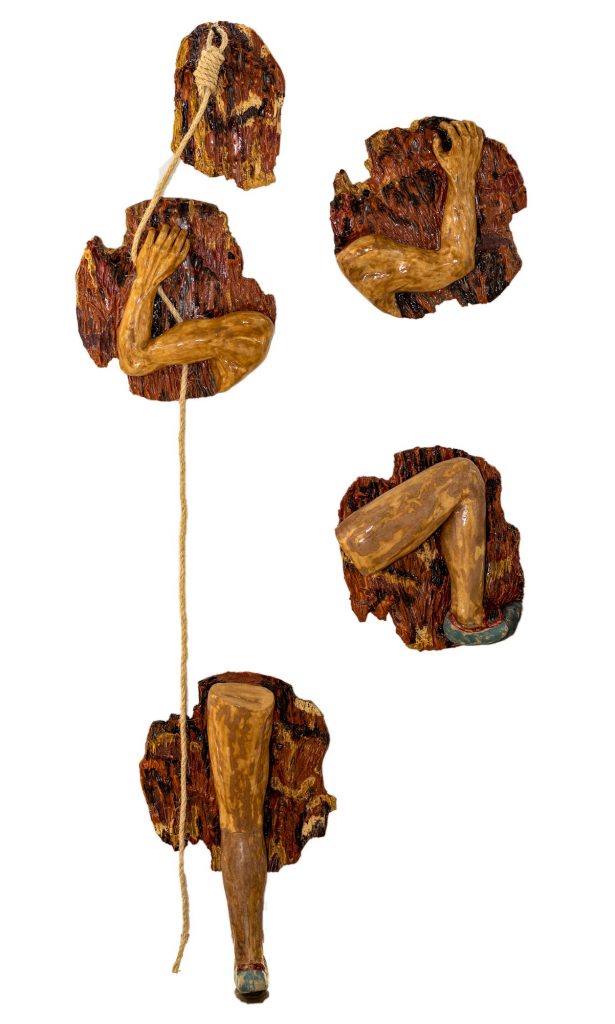Off the potter’s wheel, ceramics are often affectatious. Pninah Shakedi shows us that they don’t have to be.

Michelangelo Buonarroti, perhaps the best-known sculptor of all times, famously remarked “The sculpture is already complete within the marble block before I start my work. It is already there, I just have to chisel away the superfluous material.”

But what if the material the sculptor uses is amorphous rather than solid? What if it is clay rather than marble? There is something ambiguous about ceramics; it’s a material on seemingly parallel tracks. On one track, what can be more natural, more human, really, than making sculptures out of mud? Mud is everywhere and we can imagine that from the earliest dawn of hominids on planet Earth a child somewhere went outside after the rain and from the plentiful mud made a piece of art.

When I was a kid, we learned that men are different from animals because we make tools. Today we know that plenty of animals make and use tools. Yet I somehow doubt that even our closest relatives, the primates, make art. A human child, given a mud puddle will use his finger to make a drawing, will pick it up and make a mud cake. Not so a chimpanzee. Perhaps it is because we humans are ourselves made out of “adamah”, sculpted from red clay by the greatest Sculptor of them all.

In Hebrew, the words for “potter” and “creator” are one and the same. This linguistic unity harkens back to the dawn of human history when making something out of clay, a pot, a brick, a Venus figuring to pray to for that coveted child, was the most basic act of creation; it was us, mere humans, copying the Divine. In a very literal sense, a potter, even an adult and accomplished one, is a child copying the act of his Father, just like our own children copy us when they play in the mud and create from it little pieces of ephemeral art.

Ceramics of course has another track, that of the most utilitarian of all materials. We all have cupboards full of ceramic plates, cups, and bowls, and have had for millennia. Yet it was precisely that utilitarian aspect of ceramics, their versatility, their ubiquitousness, that made it possible to combine the twin tracks of creation: the piece of art and the tool. The first ceramic art was simply decorating cups and bowls. From a few strategically placed thumb prints to the exquisite paintings on classical Greek pottery whose secrets have been lost forever, ceramic art was born simply because leaving that vessel unadorned would have been deeply un-human.

But what about ceramic art for the sake of art? The amorphous nature of clay and the lack of a potter’s wheel leave everything to the artist’s imagination. There is no cylindrical symmetry born of the wheel, not even the veins and imperfections of marble to guide his hand. It all has to happen in the artist’s spiritual universe first and only then find its three dimensional interpretation.

Such are the sculptures of the Karmiel artist Pninah Shakedi that will be on display at the Migdal Gallery on 3 Daniel Frish street in Tel Aviv from December 13th, 2019 through January 10th, 2020. Her sculptures are all one ofs, all unique, and I can find little that brings them together. Perhaps that is why I love a few pieces and others leave me indifferent. I’m sure most of you, my dear readers, would find my choices befuddling and strange because you would have a completely different emotional reaction to them.

Pninah’s wide variety of techniques, styles, colors, and even display methods forces us to relate to each piece separately, singularly, rather than to the artist’s oeuvre as a whole. Pninah has been an artist for a while now and as an art teacher for many decades she is a consummate professional; nothing leaves her studio that is not “perfect”. This is not amateur hour. In the truest sense of that overused expression, each of Pninah’s pieces is a “conversation piece”, so go and have some conversations; you won’t be wasting your time.
- Sifting Monday’s Political Wreckage For Answers
- Ukraine, Russia Agree On Full Cease-Fire, ‘All For All’ Prisoner Swap By End Of 2019


